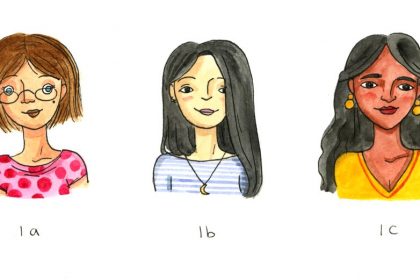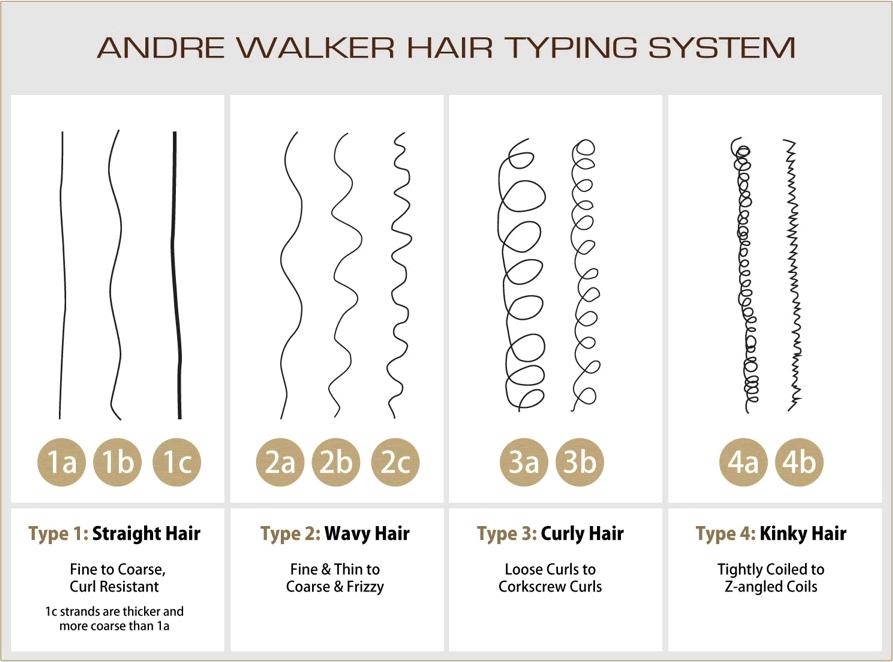Know Your Hair Types

Know Your Hair Types
What is your hair type? Most people would answer curly or straight but there are actually more types than that. There are even multiple hair typing systems that classified these types but the foundation of most systems is built upon the Andre Walker System. Knowing your hair type means better knowing yourself, your genetic inheritance, easier to search for hair products and the best way to wear and style your hair. Hair typing systems were created as a uniform set of descriptors when discussing the many varieties of curls, coils, and waves.

To discover your natural texture, clean your hair off any styling products by thorough washing before examining your strands in front of the mirror. The Andre Walker System can be broken down into 4 sections (Numbered 1 to 4) with 3 separate subsets (labelled A to C) respectively. Sometimes, individual could have a head with a mix of two or three categories.

Type 1 Hair (1a,1b,1c)
-All Type 1 hair are naturally straight hair. Type 1a hair is very fine, very soft and the straightest of all three subsets. This make this hair type the most greasy and oily of all because natural oils from scalp can travel easily to the tip of the hair since there are no curls or kinks to disrupt this oil movement. This means it has to be washed more often.
-Type 1b hair is a little bit coarser, thicker and has more volume than Type 1a hair. Type 1b hair also tends to have fuller strands with a slight bend at the ends.
-Type 1c hair is the most common among Asian women. It is the most coarse and thick and has the highest tendency to frizz compared to the other type 1 hair subtypes.

Type 2 Hair (2a,2b,2c)
-Type 2 hair are naturally wavy and forms an ‘S’ shape. These hair types are not as oily as Type 1 due to their wave textures, but these are not dry as well.
-Type 2a wavy hair is made of fine or thin hair that has a “definite “S” pattern with a natural sheen. However, this type of waves usually lack definition and volume.
-Type 2b wavy hair has a medium texture, tends to frizz more than 2a especially at the crown and it is slightly more resistant to hair styling.
-Type 2c wavy hair is the thickest, coarsest, most frizzy and most resistant to styling of all the Type 2 wavy hair. Sometimes Type 2c hair will contain a mixture with Type 3a.

Type 3 Hair (3a,3b,3c)
-Type 3 hair appears to be straight when wet but returns to curly once dried. The level of curliness and fizziness depends on humidity. Type 3 hair is very voluminous and sheen and is fairly easy to style.
-Type 3a hair has well defined spring loopy ‘S’ pattern curls which are pretty lose and have volume or fullness but it is much prone to frizzing, and easier to lose definition when compared with any of the other type 3 hairs.
-The 3b hair is much voluminous than type 3a but has smaller diameter i.e. about the sharpie marker size. Its texture is coarser and less shiny when compared to 3a.
-Hair type 3c is the coarsest and most prone to frizz in type 3 hair. It has well defined, corkscrew like coils (curly with spiral), whose size range from those of a pencil to a small sized marker. It also has slightly a greater density, and volume.

Type 4 Hair (4a,4b,4c)
Type 4 hair is the common hair types for African but with so many interracial marriages and genetic crossover, anyone can have this type of hair. It is called the natural kinky hair or coily hair. This is the coarsest, driest and most knotted of all the other types of hair in the system. It has lots of turns and twists and many strands packed together. This texture makes it hard for it to retain moisture and to look shiny as well as able to hide the true length of the hair. Its appearance can range from being fine to wiry to course.
-Type 4a hair tends to be very fragile, tightly coiled, and can feature curly patterning. The spirals are about the diameter of a crochet needle that could be fine or wiry texture with a relatively high density.
-Type 4b kinks form a ‘Z’ shape and tends to range from being fine to wiry to coarse and it is densely packed and coiled tightly with capability of shrinking for up to 75% to its length.
-Type 4c hair can also range from fine, thin, soft to coarse with densely packed strands. Type 4c coils look identical to Type 4b except that the curls are tight kinks with less definition and less curly pattern.

Regardless of the hair types, if there is any hair thinning issues or balding patches on top of your head. Toppik building fibres will come for the rescue as it claimed to work on any hairstyle and on a wide range of natural colours. Log on to www.toppikmalaysia.com/blog to read more and click on to www.toppikmalaysia.com/shop to do your online shopping. You will be amazed by the end results of the product. Also www.toppikmalaysia.com offers many information on various hair issues.
